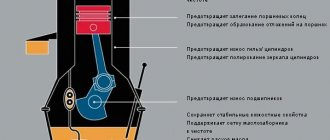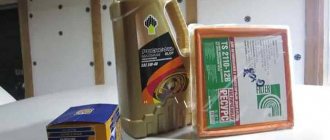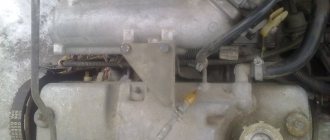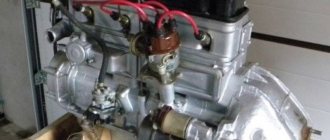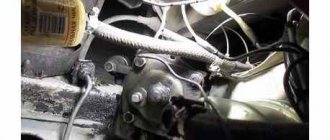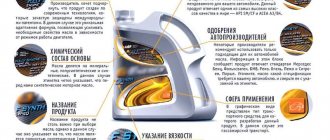VAZ 2101 is one of the first mass-produced Soviet cars, which was produced for two decades. The famous “penny” was equipped with a 1.2-liter carburetor four-cylinder engine. The VAZ 2101 gasoline engine established itself as an unpretentious, economical and easy-to-repair engine that could run on 76 gasoline and lasted on the assembly line for more than 20 years without any upgrades.
Characteristics of the VAZ 2101 engine
VAZ 2101 (1970 – 1983) is one of the first domestic models, which was produced for twenty years.
The car included a 1.2-liter carburetor 4-cylinder engine. Table of technical characteristics of the VAZ 2101 engine
| PARAMETER | MEANING |
| When were they released? | 1970 – 1983 |
| Weight, kg | 114 |
| Cylinder block, material | cast iron |
| Engine power system | carburetor |
| engine's type | in-line |
| Working volume, l | 1.2 |
| Power, hp/5600 rpm | 59 |
| Number of cylinders | 4 |
| Number of valves per cylinder | 2 |
| Piston stroke, mm | 66 |
| Cylinder diameter, mm | 76 |
| Compression ratio | 8.5 |
| Torque, Nm/rpm | 89 Nm / 3600 |
| Environmental standards | EURO 2 |
| Fuel | AI 76 |
| Fuel consumption in the combined cycle, l/100km | 9,2 |
| What kind of oil | 5W30 - 15W40 |
| Oil volume, l | 3,75 |
| When changing oil, pour, l | 3,5 |
| Oil change frequency, thousand km | 15 |
| Engine life, thousand km: - according to the plant - in practice | 125+ 200+ |
The VAZ 2101 engine is easy to maintain and operate, consumes fuel economically and is easy to repair, and is also capable of running on 76 gasoline without any “upgrades.” The release of the product has been relevant for 20 years!
Peculiarities
Engines 2101 are distinguished by their simplicity of design, which significantly simplifies repair work. The power unit, unpretentious to use, did not cause any special problems for its owners and could, if provided with proper care, run 150-200 thousand kilometers.
It was originally designed to run on low-octane fuel, which significantly reduced the owners' costs for operating the vehicle. The VAZ 2101 engine power of 59 horsepower was enough to accelerate a compact and light car.
What engine can be installed on a VAZ 2101
Owners of vintage cars may sooner or later face the issue of engine failure. If other parts are in order, but the car is needed for work purposes, and not for show-off, then replacing the engine is the most rational and profitable solution in this case.
When looking for alternative equipment, you need to pay attention to a number of points.
- Dimensions. The space under the hood of the VAZ 2101 must match the dimensions of the new engine system (otherwise cutting of the body may be necessary).
- Power. The power of the device must be identical to the capabilities of the previous engine (otherwise the body will have to be strengthened and half of the components will have to be modernized).
- Drive unit. It is better to use engines from rear-wheel drive vehicles (front-wheel drive vehicles may require modernization of the transmission, brake elements and suspension).
Which engine to choose?
- It is better to opt for native engines: VAZ 21011, 2103, 2106 or even 2113 . This will allow you to spend a minimum of effort on alterations, and in some cases get an almost new engine (which cannot be said about worn-out engines from foreign cars).
- 2108-2170 models , you will need to cut the body and there is no way to do without it. But overall, there won’t be too many problems, and therefore, “the game is worth the candle.”
- You can also pay attention to the 1.7 Niva (you will need to supplement the engine with an oil pump and a sump).
- 21126 engine from Lada Priora is also a good solution. One and a half liters of volume and almost 100 horsepower will “invigorate” the VAZ 2101 and give it a new life.
- When using foreign cars as a donor, you must be prepared that the transplant procedure will take longer. The best engines for the VAZ 2101 will be: Fiat Argenta 2.0i, BMW M10, BMW M20, Renault Logan, Volkswagen 2.0i 2E, Lancia Thema and Mitsubishi Galant.
Flaws
The power unit was developed on the basis of a prototype FIAT 124 engine, so it was not without its characteristic shortcomings that worried car owners:
- For example, the use of first-generation carburetors led to an increase in fuel consumption. Even in mixed mode, this 1.2 liter engine consumed about 10 liters per 100 kilometers.
- Quite often there were problems with the ignition, which constantly required adjustment.
- Also, during operation, the valve clearances were lost, which led to problems in the operation of the power unit. As a result, it was necessary to carry out complex and time-consuming repairs that involved opening the valve cover.
What kind of oil to pour into the VAZ 2101 engine
The higher quality the oil, the longer the service life of the engine. Currently, hundreds of varieties and dozens of oil brands are available to car owners, but they are divided into 3 categories :
- mineral oils (natural - used for used engines);
- semi-synthetic motor oils (artificial - for extreme trips);
- synthetic oils (semi-synthetic - for general purpose).
To make the right choice, you need to be guided by the manufacturers' data. You also need to take into account that artificial and semi-artificial oils contain additives that destroy gaskets on older car models. For this reason, you should not use the engine of an old VAZ 2101 with artificial oil. Otherwise, it may result in a quick breakdown.
As for viscosity, it is indicated by two numbers and a letter between them, for example 5W-50. The first part of the marking indicates viscosity at negative temperatures. The second is when heated.
When choosing oil for a VAZ 2101 engine, you must:
- Give preference to products recommended by the manufacturer.
- If the mileage is more than one hundred thousand kilometers, it is recommended to replace synthetic oil with semi-synthetic oil.
- It is recommended to change the oil every 10-15 thousand kilometers.
- In cars manufactured before 2000, it is recommended to use standard type oils (AZMOL SUPER 15W-40, 20W-40; SHEL HELIX 10W-40, etc.).
- In cars after 2000, use “super” oil (LADA-SUPER 5W-40, 10W-40, 15W-40; MOBILE SUPER M15W-40, etc.).
- For fast trips, it is better to use a substance with a high degree of viscosity when heated (0W-50, 5W-50, 10W-50, etc.).
- For trips in winter, the best option would be 10W-40.
Table “Selection of oil according to VAZ recommendations”
| Minimum engine cold start temperature, ͦС | SAE viscosity grade | Maximum ambient temperature, ͦС |
| -35 | 0W-30 | 25 |
| -35 | 0W-40 | 30 |
| -30 | 5W-30 | 25 |
| -30 | 5W-40 | 35 |
| -25 | 10W-30 | 25 |
| -25 | 10W-40 | 35 |
| -20 | 15W-40 | 45 |
| -15 | 20W-40 | 45 |
Advantages and disadvantages
In the first years of operation, the 2101 engine revealed the following shortcomings:
- noisy operation of the chain drive;
- increased gasoline consumption in the engine due to defects in carburetors;
- frequent ignition adjustments;
- Difficult adjustment of valve clearances.
Solex carburetor
However, a cylinder head improved with a camshaft, an improved intake manifold and an exhaust manifold of the simplest design compensated for these shortcomings. A little later, DAAZ Ozone carburetors were developed, replacing which made it possible to improve the characteristics of internal combustion engine modes.
Carburetor Ozone
VAZ 2101 engine repair
Repairing an engine or carrying out its overhaul requires specialized knowledge and appropriate equipment in the workshop. First of all, the engine must be removed from the car.
What is needed to remove the engine?
- inspection hole (allows access to a number of fasteners);
- special equipment for lifting and moving the engine (telpher);
- various tools (keys, screwdrivers and other small things);
- a basin (or bucket up to five liters) for coolant;
- marker (you can use chalk);
- 2 protective covers for the front fenders of the car (will be needed when removing the engine from the compartment).
To remove the VAZ 2101 engine, you must adhere to the following steps:
- Installation of transport on the inspection pit.
- Unfasten the hood from the body by unscrewing the nuts at the junction with the canopies. To avoid further difficulties with measuring the gaps of the part, before dismantling it, you need to circle the canopies with a marker. These marks will allow you to install the hood back in the same position as before.
- Place a blanket on the front fenders of the car.
- Drain the coolant from the cylinder system into a bucket by unscrewing the drain plug.
Unscrew the coolant drain plug - Make the clamps on the pipes connected to the radiator on each side weaker. Remove the pipes and leave them nearby for a while.
Loosen the clamps securing the pipes - Disconnect the leads from the spark plugs. Do the same with the distributor and oil pressure sensor. To keep the parts out of the way, they need to be moved to the side.
- Loosen the clamps on the fuel conductor tubes. Remove the hoses that go from the line to the pump, filter elements and carburetor.
Tighten the gas pipe clamps - Disconnect the outlet manifold and the receiving tube by unscrewing the two nuts on the studs.
Unscrew the bolts - Disconnect the terminals from the battery and remove it.
- Unscrew the 3 nuts securing the starter. Remove the device and put it aside.
- Unscrew the 2 bolts located on top of the gearbox mounting to the engine.
- Loosen the clamps on the heater radiator pipes. Disconnect the pipes.
- Remove the throttle valve actuators from the carburetor. Do the same with the air damper.
- It is convenient to dismantle the clutch cylinder from a pit. It is necessary to remove the tension spring and unscrew the 2 bolts on the fastening element. Remove the removed part from under your hands.
- Unscrew the 2 bolts securing the gearbox.
- Unscrew the 4 bolts holding the casing.
- Unscrew the nuts securing the motor to the 2 supporting elements.
Unscrew the engine mounts - Place lift chains on power equipment. Make sure the fastening is correct.
- Engage 1st gear and slowly begin lifting the engine with an electric hoist. In this case, you need to act measuredly and clearly so that the product does not come out of the guides.
- Carefully lift the motor and lower it to a surface (floor, table, workbench, etc.).
If you follow the steps above, replacing the engine will not take much time and effort. However, if additional questions or difficulties arise, you should never act at random. It is better to seek help from experienced specialists.
Advantages
The engine has very few positive qualities, since it is an early development from domestic manufacturers. But despite this, they are still present in this power unit:
- Simplicity of design. This is the main advantage of the power unit, since it allows you to fix most faults yourself in the garage with minimal knowledge and a set of tools.
- Ability to operate on virtually any type of fuel. A low compression ratio allows a car with such an engine under the hood to run on gasoline with low octane ratings without any problems.
- Low cost of spare parts. Since this is a domestic engine, you can purchase spare parts for it at minimal prices, and their availability will make a large number of modern manufacturers jealous.
Do-it-yourself VAZ 2101 engine tuning
Tuning the VAZ 2101 engine with your own hands allows you to maintain the operation of the car at a high operating level, and in some situations significantly improve driving performance. However, it would be stupid to demand high competitive advantages from a car over modern innovations in the automotive industry.
Therefore, improvements should be treated primarily with research and historical interest. Only in this case will the car owner get a lot of pleasure from experimenting with his four-wheeled “friend.”
The following upgrade options are currently available and in demand.
Engine replacement
pros:
- gives new life to the car, extending its overall service life;
- allows you to make the “penny” much more maneuverable and powerful.
Minuses:
- the need to reinstall half of the car components (brake system, clutch, etc.) to more advanced ones;
- costs of time, effort and finances.
Malfunctions
| FAULTS | CAUSES AND REPAIRS |
| The appearance of a loud knock under load, which was heard even with the hood closed. | The problem is caused by misaligned valve clearance. The repair in this case consists of opening the valve cover of the VAZ 2101 engine and adjusting the gap. |
| High oil consumption. | This indicates wear on the pistons. Leaks may also appear from under the valve cover. In the first case, a serious overhaul is required. |
| Systematic overheating of the motor. | The thermostat or fan has failed. If the fan is working, the thermostat or water pump must be replaced. |
| Blue smoke comes from the chimney. | The reason for this is the failure of valve seals, guides and bushings. Repair consists of replacing damaged elements. |
Maintenance
Considering the design of the internal combustion engine, the manufacturer recommends the following maintenance schedules:
| Maintenance object | Time or mileage (whichever comes first) |
| Valve train chain | replacement after 100,000 km |
| Battery | 1 year/20000 |
| Valve clearance | 2 years/20000 |
| Crankcase ventilation | 2 years/20000 |
| Belts that drive attachments | 2 years/20000 |
| Fuel line and tank cap | 2 years/40000 |
| Motor oil | 1 year/10000 |
| Oil filter | 1 year/10000 |
| Air filter | 1 – 2 years/40000 |
| Fuel filter | 4 years/40000 |
| Heating/Cooling Fittings and Hoses | 2 years/40000 |
| Coolant | 2 years/40000 |
| Oxygen sensor | 100000 |
| Spark plug | 1 – 2 years/20000 |
| Exhaust manifold | 1 year |
With timely cleaning, the lubrication, cooling and fuel supply system operates longer without major repairs.
If there is smoke coming from the exhaust
If the engine begins to smoke, then most likely the seals on the valves have been destroyed. Or the guide bushings are completely worn out. Minor faults include, for example, incorrect carburetor settings; it creates a mixture that is too rich. And the saddest failure is the destruction of the piston rings. On the VAZ 2101, the engine was initially equipped with a classic contact ignition system. It is very picky and requires constant care, cleaning contacts, and adjusting gaps. Therefore, many motorists prefer to install a contactless ignition system. But what kind of engine can be installed on the VAZ 2101? There is only one answer to this - anyone! It all depends on how “golden” your hands are.
If the engine troits - reasons
Causes of “triple tripping” of a VAZ car engine
- Incorrect ignition timing
- Spark plug fault
- High voltage wire breakdown. Capacitor failure
- Loss of tightness in the intake manifold area (intake manifold, carburetor)
- Burnout of valve, piston
- Broken piston rings
- Incorrect valve adjustment
- Destruction and wear of rockers (valve levers)
- Cylinder head gasket failure
- Wear, hardening, destruction of valve stem seals
- Very low fuel quality
- Incorrect carburetor adjustment
- Wear of distributor shaft, rotary plate bearing
- Loss of tightness of the membrane of the vacuum ignition advancer
- Use of spark plugs that are not suitable for the engine and other “malfunctions”
- Incorrect ignition timing. With this option, I personally know not a tripping, but a seemingly slamming of the engine (missing), which is accompanied by “bouncing” of the entire engine. This is especially noticeable at idle; as the speed increases, the skips disappear. Most likely, your ignition is set too early; this may also be indicated by jerky cranking of the engine by the starter when starting.
- A faulty spark plug is one of the most common causes of engine misfiring. There is nothing special to tell here, it is important to remember and replace spark plugs regularly, and the presence of a spark on an inverted spark plug at atmospheric pressure does not indicate its full functionality, because ignition occurs under much more difficult conditions (Za Rulem magazine, dating back to Soviet times).
- Breakdown of the high-voltage wire and capacitor on the contact ignition system. A wire breakdown can be determined by replacing all the wires, as well as the capacitor. You can also try to determine the breakdown of the wire by looking at them in complete darkness; if there is a breakdown somewhere, you will see flashes.
- Loss of tightness in the collector area, as a rule, does not occur on its own. More often this happens due to incorrect assembly or bad gaskets.
- As a rule, when a piston or valve burns out, the cylinder stops working altogether or does not work for a long time. It can only be determined by measuring compression and opening the engine.
- Breakage or sticking of piston rings is also not a very common occurrence, because a number of conditions are necessary for its occurrence. You can check it by measuring the compression; if it turns out to be low, then eliminate cylinder head malfunctions in a simple way - pour a little oil into the cylinder; if the compression increases, then there is a malfunction in the piston system.
- With incorrect valve adjustment, everything is already clear - any valve may not open or close completely. Proper valve adjustment can cure this problem. Rocker wear can cause a similar problem. The valve stops opening correctly and the cylinder stops working.
- Trambler. Quite often, on not new machines, wear of both the shaft itself and the bushings in which it rotates occurs, as a result of which it becomes impossible to establish an adequate gap between the contacts. The same thing happens if the swing plate bearing is worn out. Also, misfires can occur due to depressurization in the vacuum ignition timing advancer, where the membrane may fail.

